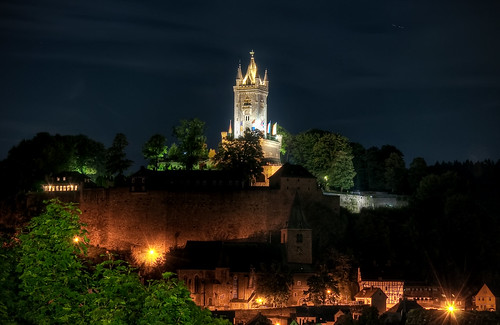Dillenburg is a town in Hesse's Gießen region in Germany. The town was formerly the seat of the old Dillkreis district, which is now part of the Lahn-Dill-Kreis.
It is located on the German-Dutch holiday road called the Oranier-Route, joining towns, cities and regions associated with the House of Orange-Nassau, as well as on the German Framework Road.
Dillenburg had its first documentary mention in 1254. Dillenburg was the ancestral seat of the Orange branch of the House of Nassau. Dillenburg Castle was built on top of the peak now called the Schlossberg in the late 13th or early 14th century. There are no pictures of this castle, however, as it was wooden, and was destroyed in the Dernbacher Feud.
From his stately home in exile, William I of Orange-Nassau, who was born in Dillenburg, organized the Dutch resistance against Spain (1567-1572), which still occasions regular Dutch royal visits to the town to this day. The land was administered by the presidents of the House of Nassau-Dillenburg. One of the last presidents was Georg Ernst Ludwig Freiherr von Preuschen von und zu Liebenstein (born 1727 in Diethardt; died 1794 in Bad Ems). In the Seven Years' War, the stately home was destroyed (1760), and Wilhelmstraße (a street) was built out of the remains. In 1875, the Wilhelmsturm (tower), views from which can be seen in this article, was completed on the Schlossberg. It is today the town's landmark. The "casemates" under the former stately home are among the biggest defensive works in Europe. They have been partly excavated and may be toured.
In the 19th century came the Industrial Revolution with the building of the Gießen-Cologne railway line – called the Sieg-Dill line – and the use of iron ore found on the Lahn, Dill and Sieg. Many mines, foundries and metalworking operations came into being in the region. In this time, many railway branchlines were built from Dillenburg to, among other places, Gönnern and Ewersbach. These lines have all been abandoned now. The line to Gönnern was abandoned in 1987 and torn up. The railway depot, so useful in the time of steam traction, was shut down in 1983.
In the Second World War, Dillenburg became a target of Allied attacks with its now closed marshalling yard. Ore mining became ever less profitable and in 1968, the last blast furnace, in Oberscheld, ceased operations.
Copyright © Demetrios the Traveler


No comments:
Post a Comment